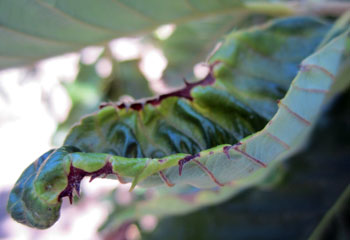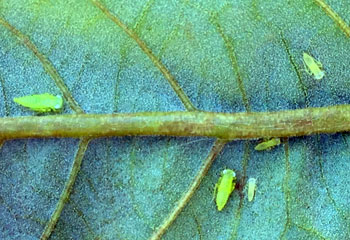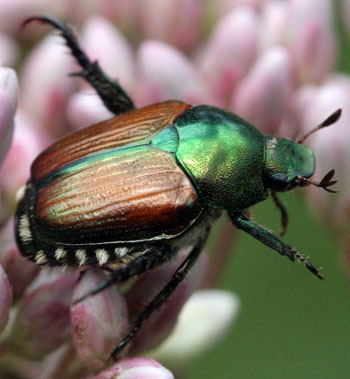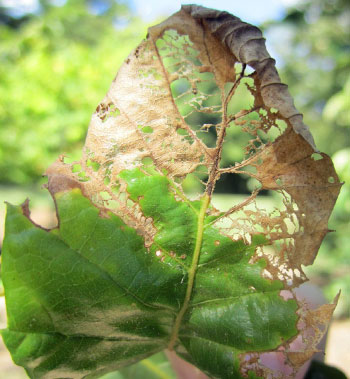Michigan chestnut update—July 9, 2014
Potato leafhopper populations are building and the first reports of Japanese beetles are coming in from southeastern Michigan. Growers should be aware of potential damage from these pests.
Degree day accumulation is significantly different along the western portion of the state where the majority of hop acreage is located. As of July 7, the Benton Harbor Enviro-weather station has accumulated 1,103 growing degree day base 50 (GDD50) with 2.4 inches of rain over the past week, the Clarksville Enviro-weather station has recorded 992 GDD50 and 2.04 inches of rain, Bear Lake has accumulated 841 GDD50 and 0.62 inches of rain and the Northwest Michigan Horticultural Research Center accumulated 841 GDD50 with just under 0.62 inches of rain this past week. Winter injury to chestnuts is being reported, primarily on marginal sites.
Potato leafhopper populations are building with a significant number of adults and nymphs on many host crops around the state. Like many plants, chestnuts are sensitive to the saliva that potato leafhoppers inject while feeding. Potato leafhopper damage to leaf tissue can cause reduced photosynthesis, which can impact production, decrease nut quality and damage the tree.
Early detection is important to prevent injury. Scouting should be performed following storm systems originating in the southern United States and weekly after first detection to monitor populations and treatment efficacy. For every acre of orchard, growers should select five trees to examine and inspect the leaves on three shoots per tree, a total of 15 shoots per acre. The easiest way to observe potato leafhoppers is by flipping the shoots or leaves over and looking for adults and nymphs on the underside of leaves. Pay special attention to succulent new leaves on the terminals of branches.
Symptoms of feeding appear as whitish dots arranged in triangular shapes near the edges. Heavily damaged leaves are cupped with dead and or yellowing chlorotic margins and eventually fall from the tree. Severely infested shoots produce small, bunched leaves with reduced photosynthetic capacity.
The most common classes of insecticides recommended for control of potato leafhoppers include the pyrethroids (bifenthrin, beta-cyfluthrin, cyfluthrin, gamma-cyhalothrin, lambdacyhalothrin, pyrethrins, zeta-cypermethrin, deltamethrin and fenpropathrin) carbamates (carbaryl), neonicotinoids (imidacloprid, thiamethoxam, acetamiprid and clothianidin) and organophosphates (malathion and phosmet). Refer to the Michigan State University Extension publication, “Pesticides Registered for Edible Chestnuts, 2014” for labeled products containing these active ingredients.
Carbamates and organophosphates are broad spectrum and can disrupt natural enemies, so only use when necessary to rotate insecticidal mode of action or to target another pest at the same time. Pyrethroids are also effective at controlling potato leafhoppers and remain relatively inexpensive. However, pyrethroids have been shown to cause increases in mite populations in other crops and should be used judiciously, particularly early in the season when mite populations have time to build over the season. Neonicotinoids are longer lasting and narrow spectrum making them a solid choice for management.


Left, A cupped leaf with necrotic edges caused by potato leafhopper feeding. Right, Potato leafhopper nymphs on the underside of a leaf. Photo credits: Erin Lizotte, MSU Extension (left) and Mario Mandujano, MSU (right)
The first report of Japanese beetles in southeast Michigan came in this week. Japanese beetle adults are considered a generalist pest and affect many crops found on or near grassy areas, particularly irrigated turf. Japanese beetle grubs feed on grass roots in early spring and again in the fall and can cause significant damage to turf. Larvae prefer moist soil conditions and do not survive prolonged periods of drought. Adult Japanese beetles emerge in early July and feed on hundreds of different plant species. Adult beetles feed on the top surface of leaves skeletonizing the tissue. If populations are high, they can remove all of the green leaf material from the plants.


Left, Adult Japanese beetle. Right, Japanese beetle feeding damage to chestnut. Photo credits: David Cappaert, MSU, Bugwood.org (left) and Erin Lizotte, MSU Extension (right)
There are no established treatment thresholds or data on how much Japanese beetle damage a healthy chestnut tree can sustain, but growers should consider that well-established and vigorous orchards will likely not require 100 percent protection. Younger orchards with limited leaf area and orchards will need to be managed more aggressively. Managing Japanese beetles can be a frustrating endeavor as they often re-infest from surrounding areas, especially during peak adult emergence in July. This re-infestation is often misinterpreted as an insecticide failure, but efficacy trials have shown that a number of insecticides remain effective treatment options.
Japanese beetle adults are a substantial insect and measure 3/8 to 1/2 inch long. The thorax is green and wingcovers are copper colored. There are five tufts of white hairs on both sides of the abdomen and a pair of tufts on the end of the abdomen that can help distinguish the Japanese beetle from other look-alike species. The legs and head are black. Visual observation of adults or feeding damage is an effective scouting technique. Growers should scout along a transect through orchards at least weekly until detection, paying special attention to the tops of trees. Because of their aggregating behavior, they tend to be found in larger groups and are typically relatively easy to spot. Pheromone and floral baited traps are available and potentially can help indicate the arrival of adults and help estimate the potential pest pressure but are not considered effective for trapping out Japanese beetles. Growers considering the traps should remember that they may attract Japanese beetle adults from the surrounding area and contribute to damage.
Carbamate (carbaryl) insecticides can provide immediate knockdown and 7 days of residual activity against Japanese beetle adults. Organophosphates (malathion and phosmet) can take longer to take effect (up to 3 days), but provides 10-14 days of residual control. Pyrethroids (bifenthrin, beta-cyfluthrin, cyfluthrin, gamma-cyhalothrin, lambdacyhalothrin, pyrethrins, zeta-cypermethrin, deltamethrin and fenpropathrin) have good knockdown activity, and 7-10 days of residual control, but can be a concern in orchards where mites are a concern. Pyrethroid use has been shown to flare mite populations, as a result of their toxicity to predatory mites which help keep pest mite populations in check. Neonicitonoids (imidacloprid, thiamethoxam, acetamiprid, and clothianidin) act initially as a contact poison for 2-5 days, and then have a longer residual period of plant protection during which they have anti-feedant effects on adult beetles. OMRI approved organic options include neem-based products (azadirachtin), which have a one to two day residual and good knockdown activity as well as Surround (kaolin clay), which has had good results in blueberries and grapes, and acts as a physical barrier and irritant. Refer to the Michigan State University Extension publication, “Pesticides Registered for Edible Chestnuts, 2014” for labeled products containing these active ingredients.



 Print
Print Email
Email




